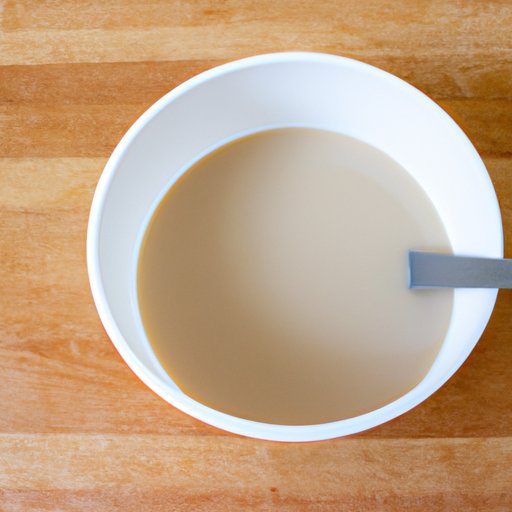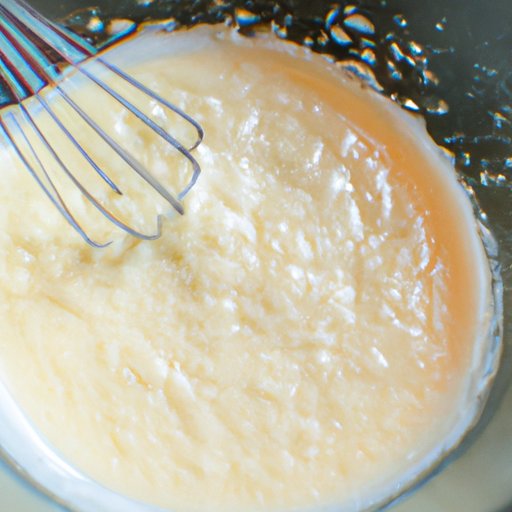Introduction
Thin gravy can put a damper on even the best of meals. Whether you’re dealing with a watery soup or a runny sauce, a lack of thickness can make any dish unappetizing. Fortunately, there are a number of techniques you can use to get that perfect thickness for your gravy. In this article, we’ll explore some of the most common thickening techniques you can use to upgrade your gravy game.
Techniques for Thickening Gravy: A Comprehensive Guide
Before diving into specific techniques, it’s important to understand what we mean when we talk about “thickening” gravy. Essentially, thickening means adding ingredients that give the gravy a thicker consistency by increasing its viscosity. There are many different techniques that can accomplish this goal, each with its own pros and cons.
Mastering the Roux: The Secret to Thick and Smooth Gravy
Roux is a mixture of flour and fat that is used to thicken sauces, soups, and gravies. The beauty of roux is that it not only thickens, but it also smooths out the sauce and gives it a deeper flavor. Here’s a step-by-step guide to making perfect roux:
- Melt butter in a pan over medium heat.
- Add an equal amount of flour to the pan and whisk until smooth.
- Cook the roux for about 5 minutes, stirring constantly, until it turns a light golden color.
- Gradually whisk in your liquid of choice (e.g. chicken or beef broth, milk) until the roux and liquid are completely combined.
- Cook the gravy over low heat, stirring frequently, until it reaches your desired consistency.
One key to using roux is to whisk it constantly, ensuring it doesn’t burn and clump up. Another tip is to use hot liquid when whisking in the roux, as this will keep the mixture smooth and uniform. Roux is a particularly useful technique when you’re looking to make gravy with a deep, rich color and flavor.

Using Cornstarch to Thicken Gravy: A Quick and Simple Solution
Cornstarch is another popular way to thicken gravies and sauces. It’s particularly useful if you want a quick and easy solution without going through the process of making a roux. Here’s how to use cornstarch to thicken your gravy:
- Mix together about 1 tablespoon of cornstarch with 2 tablespoons of cold water until the cornstarch is completely dissolved.
- Add the mixture to your hot gravy and whisk thoroughly.
- Simmer the gravy over low heat for a few minutes, whisking frequently, until it reaches your desired consistency.
While cornstarch can be an effective way to thicken gravy, it’s important to avoid clumps. That’s why it’s best to mix the cornstarch with a small amount of cold water before whisking it into the hot gravy. Once the cornstarch mixture is added to the gravy, be sure to whisk frequently to ensure a smooth, uniform texture.
Flour Power: How to Use Flour to Thicken Your Gravy
Flour is another classic thickening agent, though it requires more attention and technique to avoid creating lumps in your gravy. Here’s how to use flour to thicken your gravy:
- Mix together about 2 tablespoons of flour with 1/4 cup of water until the flour is completely dissolved.
- Slowly pour the mixture into your hot gravy, whisking constantly.
- Cook the gravy over low heat for several minutes, stirring frequently, until it reaches your desired thickness.
To avoid lumps when incorporating flour into your gravy, it’s best to use a fine-mesh sieve to sift the flour before adding it to the water. This will help to ensure a smooth, even mixture. Additionally, it’s important to pour the flour mixture into the gravy slowly while whisking constantly. Finally, be sure to stir the gravy frequently while it cooks to avoid lumps forming on the bottom of the pot.
Thick and Rich: Three Simple Tips for Achieving Perfectly Thick Gravy
While the above techniques are popular ways to thicken gravy, there are a few additional techniques you can use to upgrade your gravy game. Here are three simple tips to try:
- Reduce the gravy over low heat. By simmering the gravy for an extended period of time, some of the excess liquid evaporates, leaving you with a thicker and richer flavor.
- Puree cooked vegetables and add them to your gravy. This is a particularly good idea if you’re looking to increase the nutritional value of your gravy while also adding thickness.
- Add cream or other dairy products to your gravy. This will not only help to thicken the gravy, but it will also give it a rich and indulgent flavor.
These tips are all easy to incorporate into your existing gravy recipes, and can make a big difference in the final result. Just be sure to adjust the seasonings accordingly to maintain the perfect flavor balance.
Troubleshooting Thickening Techniques: Overcoming Common Gravy Pitfalls
Even with these techniques in your arsenal, you may still run into some issues when trying to thicken your gravy. Here are some common problems and what you can do to fix them:
- Lumps: If your gravy gets lumpy, try running it through a fine-mesh sieve to remove the lumps. Alternatively, you can try whisking it vigorously or using an immersion blender to break up the lumps.
- Inconsistency: If your gravy is too thin, try whisking in a little more of your thickening agent of choice. If it’s too thick, add a little more liquid to thin it out.
- Too thin or thick: If your gravy is too thin or thick, simply adjust the amount of thickener you’re using until you reach your desired consistency.
Remember: practice makes perfect when it comes to thickening gravy. Don’t be discouraged if your first attempt doesn’t come out perfectly; with a little experimentation, you’ll find the perfect technique for your gravy recipe.
Conclusion
Thickening gravy is an essential skill for any home cook, and with the right techniques, it’s easy to achieve. Whether you’re using classic techniques like roux and flour, or exploring newer options like cornstarch or pureed vegetables, there’s a method out there that will work for you. So don’t be afraid to experiment, and remember that practice makes perfect. With these tips and techniques in your arsenal, you’ll be making perfect, thick gravy in no time.
